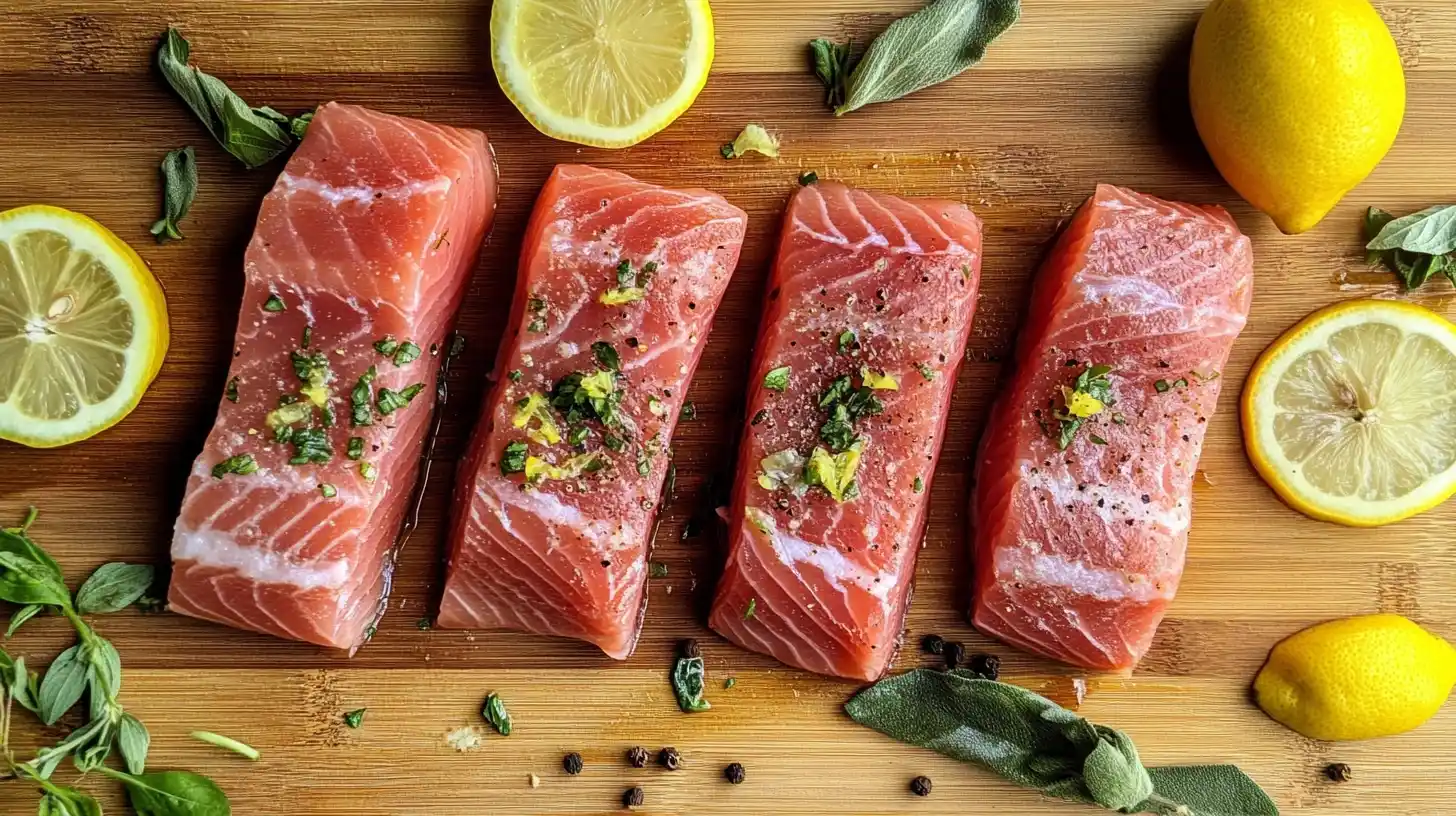Is it good to eat salmon belly? This question comes up often among seafood lovers. Known for its rich flavor and creamy texture, salmon belly is a hidden gem in the culinary world. But what makes it so special? Let’s explore why salmon belly is good for your health, how to cook it, and what risks to keep in mind.
The answer lies in its benefits, risks, and ways to enjoy it. This article will cover everything you need to know about salmon belly, from its nutritional value to its culinary uses. By the end, you’ll be ready to make informed choices about including salmon belly in your diet.
Table of contents
What is Salmon Belly?
To answer the question is it good to eat salmon belly, let’s start with what it is. Salmon belly comes from the underside of the fish, a section packed with healthy fats like omega-3 fatty acids. These fats give it a tender texture and a distinct, buttery flavor. Whether it’s used in sushi, soups, or grilled dishes, salmon belly adds richness to any recipe.

Why Is Salmon Belly Special?
The belly of the salmon stands out from other parts of the fish because of its:
- High Fat Content: Salmon belly contains more fat than the fillet or other sections. This makes it buttery, tender, and flavorful.
- Silky Texture: Unlike the firmer fillet, the belly is softer and almost melts in your mouth when cooked properly.
- Nutrient Density: Thanks to its fat content, it’s loaded with omega-3 fatty acids, which are essential for brain and heart health.
Culinary Value of Salmon Belly
In many cultures, salmon belly is considered a delicacy. It is prized for its rich flavor and versatility in cooking. Some popular uses include:
- Sushi and Sashimi: In Japanese cuisine, raw salmon belly is served as sushi or sashimi because of its velvety texture.
- Grilled or Fried: Its fat content makes it perfect for grilling or frying, as it stays juicy even under high heat.
- Soups and Stews: In Asian cooking, salmon belly is often added to broths to enhance the dish’s richness.
- Smoked or Cured: Smoked salmon belly offers a deep, smoky flavor, while cured versions are a gourmet treat.
Affordability of Salmon Belly
One of the most appealing aspects of salmon belly is its affordability. Despite being a nutrient-packed and delicious part of the fish, it is often sold at a lower price compared to the more popular fillets or steaks. This makes it an excellent choice for individuals and families looking to enjoy healthy seafood on a budget.
Why Is Salmon Belly Cheaper?
There are a few reasons why salmon belly tends to cost less:
- Perceived Value: Many people prefer leaner cuts of fish, such as fillets, leaving the belly underappreciated.
- Fat Content: The belly’s higher fat content can deter those who are unfamiliar with its culinary potential.
- Supply: Since the belly is a smaller part of the fish, there may be less demand for it compared to other sections.
A Budget-Friendly Superfood
For its price, salmon belly delivers exceptional value:
- It provides omega-3 fatty acids, vitamins, and protein at a fraction of the cost of other premium seafood options.
- A small amount goes a long way, as its richness makes it incredibly satisfying.
- It can be used in a variety of recipes, making it a versatile ingredient that stretches your dollar.
Pro Tip for Buying Salmon Belly
To get the best deal:
- Look for salmon belly at local fish markets, where it’s often sold separately from fillets.
- Ask your fishmonger for leftover belly cuts; they may be available at a discount.
- Consider buying in bulk and freezing portions for later use.
Making Healthy Eating Affordable with Salmon Belly
Eating healthy on a budget can be challenging, but salmon belly makes it possible. Packed with nutrients like omega-3 fatty acids, vitamins, and protein, it is a budget-friendly alternative to pricier cuts of fish. Its rich flavor and versatility in cooking make it a smart choice for anyone seeking both health and value.
How Salmon Belly Fits Into Affordable Meals
- Lower Cost, High Nutrition: Despite its affordability, salmon belly is a nutritional powerhouse. It offers the same essential nutrients found in fillets but at a fraction of the price.
- Satisfying Portions: Because of its high fat content and rich flavor, a small amount of salmon belly can make a meal satisfying. This means you don’t need large portions to feel full.
- Versatile Ingredient: Whether grilled, fried, or added to soups, salmon belly can adapt to a wide range of dishes, helping you create flavorful meals without expensive ingredients.
Affordable and Sustainable Eating
Pairing salmon belly with other cost-effective, nutrient-rich foods can make meals even more budget-friendly. For example:
- Combine it with seasonal vegetables for a balanced plate.
- Use it in broths or stews to enhance flavor without requiring additional expensive ingredients.
- Serve it with rice or noodles to stretch the meal further.
Tips for Maximizing Value
To get the most out of salmon belly:
- Buy Fresh or Frozen: Frozen salmon belly is often cheaper and stores well for months.
- Shop at Local Markets: Fish markets and seafood counters may sell belly cuts at a discount.
- Cook in Batches: Prepare multiple portions at once and refrigerate leftovers for later meals.
An Affordable Superfood
With salmon belly, you can enjoy the benefits of a nutritious diet without overspending. Its affordability allows more people to access high-quality seafood, proving that healthy eating doesn’t have to come at a high price.
Nutritional Profile of Salmon Belly
Salmon belly is not only tasty but also a nutritional powerhouse. It provides essential nutrients that your body needs to stay healthy. Let’s take a closer look at why it’s so good for you.
1. Rich in Omega-3 Fatty Acids
Omega-3 fatty acids are one of the key reasons salmon belly is so beneficial. These healthy fats:
- Support heart health by reducing bad cholesterol.
- Lower inflammation, which can reduce joint pain.
- Boost brain function and improve mood.
2. High in Protein
Protein is vital for building and repairing tissues in your body. A serving of salmon belly is an excellent source of high-quality protein, which helps:
- Keep you feeling full longer, aiding in weight management.
- Support muscle growth and repair.
3. Packed with Vitamins and Minerals
Salmon belly is full of important vitamins and minerals, including:
- Vitamin D: Helps your body absorb calcium for stronger bones.
- Vitamin B12: Supports brain health and energy production.
- Selenium: An antioxidant that protects cells from damage.
4. Good for Skin and Hair
The healthy fats and vitamins in salmon belly can improve skin elasticity and hair strength, giving you a natural glow.
Benefits of Eating Salmon Belly
1. Rich Source of Omega-3 Fatty Acids
Omega-3 fatty acids are known to improve heart health and lower inflammation. Furthermore, they support better brain function and even reduce the risk of depression.
2. Supports Weight Management
- Salmon belly’s protein helps you feel full for longer, which can prevent overeating.
- Its healthy fats provide steady energy without causing blood sugar spikes.
3. Improves Skin and Hair Health
The omega-3s and antioxidants in salmon belly are great for your skin. They help maintain elasticity and reduce signs of aging.
4. Boosts Mental Well-being
Studies suggest that omega-3s can enhance mood and improve mental focus. They’re ideal for anyone looking to support their mental health naturally.

Culinary Uses of Salmon Belly
Still curious, is it good to eat salmon belly? Its versatility in the kitchen makes it a favorite for chefs and home cooks alike. Here are some popular ways to use it:
- Sushi and sashimi: Salmon belly’s smooth texture is perfect for raw dishes.
- Grilled or pan-seared: The fat content ensures it stays juicy and flavorful.
- Soups and stews: Adding salmon belly enhances the richness of broths.
Whether you’re grilling or making a soup, salmon belly will answer your question: is it good to eat salmon belly?
Salmon belly’s versatility allows it to shine in many dishes:
- Sushi and sashimi: Its buttery texture is ideal for raw preparations.
- Grilled dishes: Retains moisture and develops a crispy exterior.
- Stews and soups: Adds a rich flavor base.

Want to compare salmon belly to other seafood options? Deepen your knowledge about seafood mix stacks up.
Popular Ways to Use Salmon Belly
Here are some of the best ways to enjoy salmon belly:
- Sushi and Sashimi: The buttery texture of salmon belly makes it perfect for raw dishes like sushi and sashimi. A little soy sauce and wasabi can enhance its natural flavors.
- Grilled or Pan-Seared: Grilling or pan-searing salmon belly gives it a crispy outside while keeping the inside moist and tender.
- Soups and Stews: Add salmon belly to broths or stews for a rich, savory flavor.
- Stir-Fries: Its high fat content works well in quick stir-fried dishes with vegetables and sauces.
Preparation Tips
To get the best flavor and texture from salmon belly, follow these simple tips:
- Clean Properly: Rinse the salmon belly well to remove any scales or residue.
- Season Lightly: A little salt, pepper, and lemon juice is enough to highlight its natural taste. Avoid overpowering it with too many spices.
- Cook Gently: Because of its fat content, salmon belly cooks quickly. Use medium heat to avoid overcooking.
- Pair Thoughtfully: Pair salmon belly with light, fresh ingredients like herbs, citrus, or greens to balance its richness.
Easy Recipe Ideas
- Grilled Salmon Belly with Lemon and Herbs: Marinate with olive oil, garlic, and herbs, then grill until lightly charred.
- Salmon Belly Miso Soup: Add pieces of salmon belly to a miso-based broth with tofu and seaweed.
- Pan-Seared Salmon Belly: Cook in a hot pan with a touch of butter and serve with steamed vegetables.
Potential Risks and Ethical Considerations
While salmon belly is packed with health benefits, there are a few things to consider before making it a regular part of your diet. Understanding the potential risks and sustainability concerns can help you enjoy this delicacy responsibly.
1. Potential Health Risks
Although salmon belly is highly nutritious, consuming it in excess may have some downsides:
- Mercury and Contaminants: Like many types of seafood, salmon may contain trace amounts of mercury and other pollutants. These can build up in the body if consumed too often.
- High Fat Content: While the fats in salmon belly are healthy, they are calorie-dense. Eating too much can lead to weight gain if not balanced with other foods.
2. Sustainability Concerns
Overfishing and unsustainable farming practices have raised concerns about the impact of salmon production on the environment. Here’s what you can do to make more ethical choices:
- Choose Wild-Caught Salmon: Wild-caught salmon is generally considered more sustainable than farmed salmon, though it can be more expensive.
- Look for Certifications: Look for labels like Marine Stewardship Council (MSC) certification to ensure your salmon was caught responsibly.
- Support Sustainable Seafood Initiatives: Organizations like Seafood Watch offer guidance on making environmentally friendly seafood choices.
FAQs About Eating Salmon Belly
Here are some common questions people have about eating salmon belly. These answers will help you make informed decisions while enjoying this nutritious and delicious part of the fish.
1. Is salmon belly healthier than salmon fillet?
Yes, salmon belly is considered healthier in some ways because it contains more omega-3 fatty acids. These healthy fats are excellent for your heart and brain. However, it’s also higher in calories due to the fat content.
2. Can I eat salmon belly every day?
While salmon belly is packed with nutrients, it’s best to enjoy it in moderation. Eating it daily might expose you to trace amounts of mercury or excess fats. Including a variety of seafood in your diet is a smarter choice.
3. What is the best way to cook salmon belly?
Grilling or pan-searing salmon belly is ideal as it brings out its rich flavor while keeping the texture tender. You can also use it in soups, stews, or even raw in sushi and sashimi.
4. Is salmon belly safe for pregnant women?
Yes, pregnant women can eat salmon belly, but they should limit their intake to avoid excessive mercury exposure. Stick to two to three servings of low-mercury fish per week.
5. How does salmon belly compare to other fish?
Salmon belly stands out because of its omega-3 richness and creamy texture. It’s more flavorful and nutrient-dense compared to leaner fish like cod or tilapia.
6. Can I freeze salmon belly?
Yes, you can freeze salmon belly.To preserve its quality, wrap it tightly in plastic wrap or store it in an airtight container before freezing. Thaw it slowly in the fridge before cooking.
Conclusion
So, is it good to eat salmon belly? Absolutely! It’s delicious, nutrient-rich, and versatile. From its high omega-3 content to its affordability, salmon belly proves to be a great addition to any meal. Whether you grill it, add it to a stew, or enjoy it raw, salmon belly is a treat you don’t want to miss.
While it is important to be mindful of potential risks like mercury exposure and sustainability issues, these concerns can be addressed by choosing responsibly sourced salmon and enjoying it in moderation. Whether grilled, in soups, or as part of a sushi dish, salmon belly is sure to delight your taste buds.
So, why not try incorporating this underrated delicacy into your next meal? Not only will it elevate your cooking, but it will also support a healthy and balanced diet. Give salmon belly a chance, and enjoy its benefits while making thoughtful choices for the environment.

